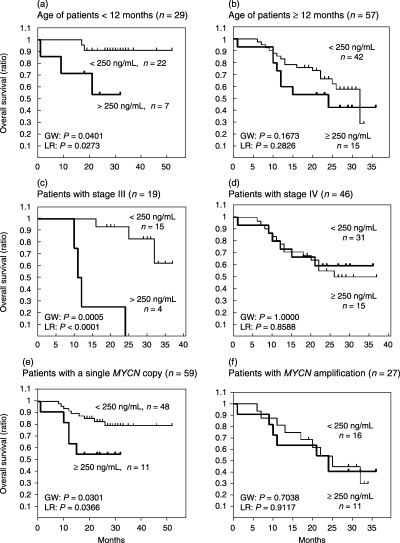Figure 3.

Clinical significance of the serum NM23‐H1 levels in the groups classified according to the age of the patients, or stage of the disease, or copy number of MYCN. (a) Survival curves for seven patients with a serum NM23‐H1 level of ≥ 250 ng/mL, and for 22 patients with a level < 250 ng/mL. Both groups of patients were younger than 12 months of age. (b) Survival curves for 15 patients with a serum NM23‐H1 level of ≥ 250 ng/mL, and for 42 patients with a level < 250 ng/mL. Both groups of patients were 12 months old or older. (c) Survival curves for four patients with a serum NM23‐H1 level of ≥ 250 ng/mL, and for 15 patients with a level < 250 ng/mL. Both groups of patients were at stage 3 of the disease. (d) Survival curves for 15 patients with the serum NM23‐H1 level ≥ 250 ng/mL, and for 31 patients with the level < 250 ng/mL. Both groups of patients were at stage 4 of the disease. (e) Survival curves for 11 patients with a serum NM23‐H1 level of ≥ 250 ng/mL, and for 48 patients with a level < 250 ng/mL. Both groups of patients had a single copy of MYCN. (f) Survival curves for 11 patients with a serum NM23‐H1 level of ≥ 250 ng/mL, and for 16 patients with a level < 250 ng/mL. Both groups of patients had MYCN amplification in the tumor. GW, generalized Wilcoxon's test; LR, log‐rank test.
